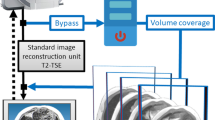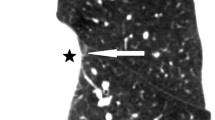Summary
The aim of this work was to describe the radiologic anatomy of the inferior lung margins (ILMs). The method was to enhance the low frequencies of 50 normal chest computed radiographs. On each side, the anterior and posterior ILMs were divided into two halves. The frequency of visibility of each half of each ILM was calculated as their shape, lateral and medial continuities, depth, and vertebral level. The differences were compared by a paired Studentt-test. The right posterior ILM was always visible and usually concave upward (94%). Its height was 8.7 ± 1.6 cm. Its most inferior part faced L1 or L2 in 92% of cases. It was continuous medially inside with the azygo-esophageal recess in 96% of cases. The left posterior ILM was not visible laterally in 34% of cases and medially in 60% of cases. It was most often concave upward (82% of cases). Its height was 6.9 ± 1.5 cm. Its most inferior part was at the level of L1 or L2. It was continuous medially with either the left paraspinal line or the paraaortic line. The right anterior ILM was visible in 76% of cases. It was most often oblique upward and medially (46%) or concave upward (33%) and often notched (38%). The left anterior ILM was visible in 64% of cases and more often oblique inward and upward (58%). It was continuous medially with the left inferior precardiac recess. The anterior ILMs were more variable than the posterior. The posterior ILMs were very similar in shape and inferior level and differed in depth only by the difference of height of the diaphragmatic cupolas.
Résumé
Le but de ce travail était de décrire l'anatomie radiologique des recessus pulmonaires inférieurs (RPI). Le matériel et la méthode ont consisté à amplifier très fortement les basses fréquences de 50 radiographies numérisées normales du thorax. De chaque côté les RPI antérieurs et postérieurs ont été divisés en deux moitiés (interne et externe). La fréquence de la visibilité de chaque moitié de chaque RPI a été calculée ainsi que leur forme et leur continuité interne et externe, leur profondeur, leur niveau le plus bas en se repérant par rapport aux vertèbres. Les différences ont été comparées avec le test-t de Student apparié au niveau p=0,05. Le RPI postérieur droit était toujours visible et le plus souvent concave en haut (94 %). Sa hauteur était de 8,7 ± 1,6 cm. Son niveau le plus bas se situait en regard de L1 ou L2 dans 92% des cas. Il se poursuivait en dedans avec le recessus azygo-oeosophagien dans 96% des cas. Le RPI postérieur gauche n'était pas visible en dehors dans 34 % des cas et en dedans dans 60 % des cas. Il était le plus souvent concave en haut (82 %). Sa hauteur était de 6,9 ± 1,5 cm. Son niveau le plus bas se situait à la hauteur de L1 ou L2. Il se continuait en dedans soit avec la ligne paravertébrale gauche soit la ligne paraaortique. Le RPI antérieur droit était visible dans 76 % des cas. Il était le plus souvent oblique en haut et en dedans (46 %) ou concave en haut (33 %) et fréquemment encoché (38 %). Le RPI antérieur gauche était visible dans 64 % des cas et il était plus souvent oblique en haut et en dedans (58 %). Il se poursuivait en dedans avec le recessus précardiaque inférieur gauche. En conclusion, le RPI antérieurs sont plus variables que les postérieurs. Les RPI postérieurs sont très voisins dans leur forme, leur niveau inférieur et ils ne diffèrent dans leur profondeur que par la différence de hauteur des coupoles diaphragmatiques.
Similar content being viewed by others
References
Aarts NJM, Oestmann JW, Kool LJS (1993) Visualization of basal pleural space and lung with advanced multiple beam equalization radiography (AMBER). Eur J Radiol 16: 138–142
April EW (1990) Anatomy: Pleural cavities and lungs. Williams & Wilkins, Baltimore, pp 125–128
Bouchet A, Cuilleret J (1991) Anatomie topographique, descriptive et fonctionnelle: le cou, le thorax. Les plèvres. Simep, Paris, pp 1089–1096
Felson B (1973) Chest Roentgenology. WB Saunders, Philadelphia, p 574
Fraser RG, Paré JAP, Fraser RS, Genereux GP (1988) Diagnosis of diseases of the chest. WB Saunders, Philadelphia
Gardner E, Gray DJ, O'Rahilly R (1975) Anatomy. A regional study of human structures. WB Saunders, Philadelphia
Gosling JA, Harris PF, Humpherson JR, Whitemore I, Willan PLT (1990) Human anatomy. Text and colour atlas. Gower Medical Publishing
Lachman E (1942) A comparison of the posterior boundaries of lungs and pleura as demonstrated on the cadaver and on the roentgenogram of the living. Anat Rec 83: 521–542
Morrissey BM, Bisset RAL (1993) The right inferior lung margin: anatomy and clinical implication. Br J Radiol 66: 503–505
Whale W, Leonhardt H, Platzer W (1978) Anatomie: viscères, poumons. Flammarion Médecine Sciences, Paris
Williams PL, Warwick R, Dyson M, Bannister LH (1995) Gray's Anatomy. Churchill Livingstone, Edinburgh, pp 1657–1670
Author information
Authors and Affiliations
Rights and permissions
About this article
Cite this article
Frija, J., de Kerviler, E. & Zagdanski, A.M. Radiologic anatomy of the inferior lung margins as demonstrated on computed radiography with enhancement of low frequencies. Surg Radiol Anat 19, 257–263 (1997). https://doi.org/10.1007/BF01627870
Received:
Accepted:
Issue Date:
DOI: https://doi.org/10.1007/BF01627870




